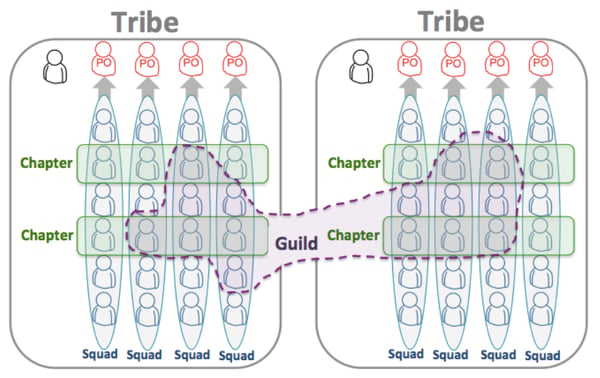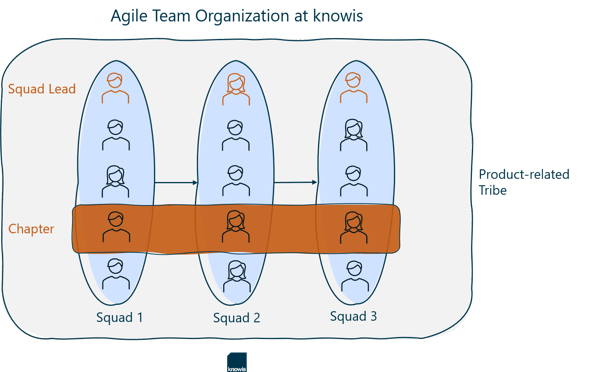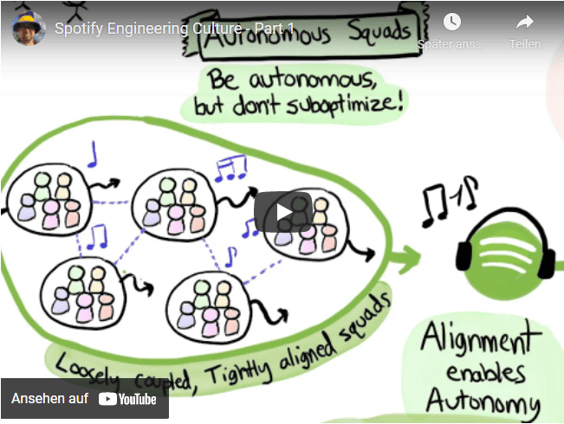
Squad, Tribe, Guild and Chapter. What sounds like the content of an online role-playing game, such as World of Warcraft, is the basis for an agile work model in a business context. The software industry has always been a good breeding ground for new approaches to work organization, often a trailblazer for other economic sectors, and it has already produced many pioneering procedural models. At knowis, too, promising ideas are repeatedly put through their paces and, if successful, find their way into everyday work. Read about our first experiences with agile team organization based on the Spotify model.
Agile has been the epitome of modern software development and lean, flexible processes for many years. Whether they are using Scrum, Kanban, or one of their diverse variations – almost all development teams have moved away from the classic waterfall or the V-model. However, the situation is different for the higher-level team organization. Here, classical hierarchies and rigid structures are often still the order of the day and agility ends at the office door of the respective team.
As early as 2012, the Swedish music streaming company Spotify was thinking about how to make development units more dynamic and use skills in a more targeted manner by forming small, cross-functional, and self-organizing teams. The result was a new division of the employees into squads, tribes, chapters, and guilds. This model is now also known as the Spotify model and is considered to be one of the most advanced agile work models in the industry. In particular, its scalability is a great advantage for growing companies.
Agile Working According to the Spotify Principle
Squads
Squads form the basis of the Spotify model. They are the smallest organizational unit and are based on the structure of classic Scrum teams. The teams should be composed in such a way that their members combine all the necessary skills to design, develop, test, and finally release software and bring it into production. Each Squad has its own area of responsibility and pursues a long-term mission within it. At Spotify, for example, one Squad is only concerned with the provision of payment services, another with the scaling of the backend systems. However, the respective mission is part of the overarching strategy and subordinate to the company's goals.
The teams basically organize themselves; However, the Spotify model provides for one Product Owner per Squad who prioritizes the team's tasks. In addition, there is an Agile Coach who, in contrast to the classic Scrum Master, supports sprint planning and retrospectives and helps to identify possible obstacles in the work processes so they are continuously improved.
Tribes
Several of these small multidisciplinary groups form a Tribe that unites developer groups from similar areas – for example, all Squads working on the same product. Each Tribe has a Tribe Lead whose job it is to ensure the best possible working environment for the Squads. Spotify recommends that the Squads within a Tribe should ideally work spatially close to each other – the physical proximity leads to improved cooperation between the Squads. Regular meetings, for example, with live demos of the software, presentations of new tools, or where members tell each other what is currently being worked on within the various Squads, promote Tribe cohesion.

Chapters and Guilds
Both large and small, the employees are linked by Chapters and Guilds: Chapters bring the members of different Squads together; Guilds connect the individual Tribes like cross braces.
In Chapters, people from the same Tribe with similar skills and areas of competence come together. This has the advantage that knowledge can be more easily transferred between the Squads without depriving the Squads of their autonomy. If, for example, a tester from Squad A has solved a problem, the testers from Squad B and C should also know, so that the problem does not have to be solved by each team individually. Each Chapter therefore meets regularly to discuss current challenges in its specific area, for example in testing.
A Guild can extend beyond the Tribes to the entire company – this makes it easier for employees with the same interests and similar tasks and responsibilities to exchange ideas. There can be Guilds for software architects, or testers, for example. In general, however, anyone who is interested in a topic can join this community. Guilds set standards for the execution of tasks across Squads and Tribes, bringing benefits to the entire organization.
Agile Best-Practices at knowis
knowis develops solution platforms for the banking industry and has been working agile following Scrum or Kanban for years. For some time now, knowis has also integrated approaches of agile team organization and established a Tribe organization.
For the creation of new software features, all employees involved in the process depend on cooperation, because a wide range of skills and abilities are required. knowis has therefore formed several Squads, each of which has a separate scope of responsibilities. These Squads contain all the cross-functional skills needed to develop software features autonomously and solve problems independently. Each Squad regularly carries out its own sprint planning. However, the respective Squad Leads exchange ideas, because the Squads all work on the same product and therefore form a Tribe.
Beyond the individual Squads, developers, product managers and testers are united through Chapters. Similar skills are promoted here and sent to the Squads as needed. In this way, employees benefit from mutual feedback across team boundaries and the company establishes an open communication culture to cultivate new ideas and knowledge exchange.

While Spotify still emphasized the importance of spatial proximity of the teams in 2012, this reorganization at knowis could be implemented without any problems, regardless of remote work and home office. It is crucial that every employee is included in the sprint planning and other important meetings and that progress is reflected on together. The establishment of cross-Tribe Guilds will now be the next development step in the agile team organization at knowis. In an interview, software developer Saja Darwish reports firsthand how this method has proven itself in everyday life.
Conclusion
The benefits of agile software development are well known: It quickly delivers tangible results, the planning can be flexibly adapted to current circumstances and findings, and there is a special focus on the transfer of information within the team. In fast-growing companies in particular, there is a need to benefit from this dynamic across teams and to use the skills available in the company in a needs-oriented and targeted manner. However, this often pushes the classic, established organizational structures to their limits and can result into bottlenecks, especially in the development area.
The agile team organization based on the Spotify model transfers the team's internal agility to entire departments or corporate divisions and also enables team members to advance their skills according to their strengths and interests. In addition, Chapters and Guilds enable a transfer of knowledge across the individual Squads, which has a positive effect on software quality. The first experiences with Tribe organization at knowis, where different squads develop features of a product on their own responsibility, independently and self-organized, have been very promising and will be intensified in the upcoming months. Despite all the restrictions resulting from Corona lockdown, remote work and hygiene concepts within the office, a positive development in cross-team software development, in common strategic understanding and in the exchange of know-how has become visible.
Sources:
Videos: Spotify Engineering Culture - Part 1. (Henrik Kniberg / YouTube)
Graphic: Spotify-Modell – Henrik Kniberg & Anders Ivarsson via https://blog.crisp.se/wp-content/uploads/2012/11/SpotifyScaling.pdf; Agile Team Organization at knowis – knowis AG.
Teaser: mbbirdy – 877042462 – iStock.









